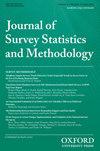基于单位水平Gamma-Pisson模型的小区域均值经验最佳预测
IF 1.6
4区 数学
Q2 SOCIAL SCIENCES, MATHEMATICAL METHODS
引用次数: 0
摘要
现有的计数数据的小面积估计程序具有重要的局限性。例如,如果模型的假设成立,则已知基于M-量的方法不如基于模型的过程有效。此外,泊松广义线性混合模型的频率论推理过程可能是计算密集型的,或者需要近似。此外,区域级别的模型不能包含单位级别的协变量。我们通过开发单位水平伽玛-泊松模型的小面积估计程序来克服这些限制。该模型的共轭形式允许计算上简单的估计和预测过程。我们得到了均值的经验最佳预测器的闭合形式表达式以及闭合形式的均方误差估计器。我们通过仿真验证了该过程。我们使用爱荷华州安全带使用调查的数据子集来说明所提出的方法。本文章由计算机程序翻译,如有差异,请以英文原文为准。
Empirical Best Prediction of Small Area Means Based on a Unit-Level Gamma-Poisson Model
Existing small area estimation procedures for count data have important limitations. For instance, an M-quantile-based method is known to be less efficient than model-based procedures if the assumptions of the model hold. Also, frequentist inference procedures for Poisson generalized linear mixed models can be computationally intensive or require approximations. Furthermore, area-level models are incapable of incorporating unit-level covariates. We overcome these limitations by developing a small area estimation procedure for a unit-level gamma-Poisson model. The conjugate form of the model permits computationally simple estimation and prediction procedures. We obtain a closed-form expression for the empirical best predictor of the mean as well as a closed-form mean square error estimator. We validate the procedure through simulations. We illustrate the proposed method using a subset of data from the Iowa Seat-Belt Use survey.
求助全文
通过发布文献求助,成功后即可免费获取论文全文。
去求助
来源期刊
CiteScore
4.30
自引率
9.50%
发文量
40
期刊介绍:
The Journal of Survey Statistics and Methodology, sponsored by AAPOR and the American Statistical Association, began publishing in 2013. Its objective is to publish cutting edge scholarly articles on statistical and methodological issues for sample surveys, censuses, administrative record systems, and other related data. It aims to be the flagship journal for research on survey statistics and methodology. Topics of interest include survey sample design, statistical inference, nonresponse, measurement error, the effects of modes of data collection, paradata and responsive survey design, combining data from multiple sources, record linkage, disclosure limitation, and other issues in survey statistics and methodology. The journal publishes both theoretical and applied papers, provided the theory is motivated by an important applied problem and the applied papers report on research that contributes generalizable knowledge to the field. Review papers are also welcomed. Papers on a broad range of surveys are encouraged, including (but not limited to) surveys concerning business, economics, marketing research, social science, environment, epidemiology, biostatistics and official statistics. The journal has three sections. The Survey Statistics section presents papers on innovative sampling procedures, imputation, weighting, measures of uncertainty, small area inference, new methods of analysis, and other statistical issues related to surveys. The Survey Methodology section presents papers that focus on methodological research, including methodological experiments, methods of data collection and use of paradata. The Applications section contains papers involving innovative applications of methods and providing practical contributions and guidance, and/or significant new findings.

 求助内容:
求助内容: 应助结果提醒方式:
应助结果提醒方式:


